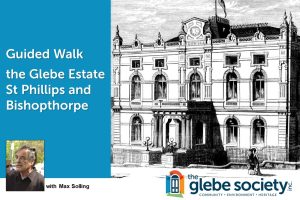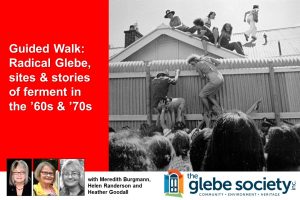By Dorothy Davis and Katharine Vernon, Guided Walks Coordinators, Bulletin 1/2024, March and updated monthly

Bookings for all Walks is through Eventbrite.
Upcoming Guided Walks
| Saturday 25 May, 2–4 pm | The Glebe Estate: St Phillips and Bishopthorpe Leader: Max Solling Meeting place: front of Glebe Town Hall, 160 St Johns Road, Glebe, Cost: $20 (members); $25 (non-members) Bookings: http://glebe-estate-st-phillips-bishopthorpe.eventbrite.com.au/ |
| Sunday 16 June, 2–4 pm | The Hidden History of Blackwattle Bay Leader: Ian Stephenson Meeting place: Outside the front door of the Chau Chak Wing Museum at Sydney University Cost: $20 (members); $25 (non-members) Bookings: TBA |
| Wednesday 3 July 9:30 am–4 pm | Rookwood Cemetery and Back: A Bus Tour visiting the burial sites of some famous Sydney families and Glebe identities Leader: Max Solling Meeting place: Mitchell Street Glebe (exact location to be advised) Cost: $58 (covers bus trip, tour and lunch) Bookings: TBA, from early June |
More about the walks
 The Glebe Estate: St Phillips and Bishopthorpe
The Glebe Estate: St Phillips and Bishopthorpe
2024 marks 50 years since the Whitlam Government purchased the ‘Glebe Lands’, i.e. much of the area bounded by St Johns Rd and Broadway.
The Glebe Society played a key role in campaigning for this significant part of old Sydney’s heritage to be preserved, thus enabling families who had lived here for generations, to remain as an intact community. The intervention by the Whitlam Government prevented the demolition of many Glebe houses and the dispersal of their inhabitants.
Max Solling will lead this Walk, which traces some of the early European settlement of ‘The Glebe’, including the 1842 subdivision of St Phillips into small allotments and the 1856 subdivision of Bishopthorpe. Max’s walks are always popular; he shares his deep knowledge of Glebe’s history in an engaging way through stories of past events and people. This walk is highly recommended.
The Hidden History of Blackwattle Bay

Starting at Victoria Park which was one of the headwaters of Blackwattle Bay this walk will explore some of the less well known parts of Glebe and its neighbours. It will include the Bishopgate estate off Broadway (not to be confused with the better known Bishopthorpe estate to the west of Glebe Point Road); the site of the former Brisbane Distillery in nearby Chippendale which was located on another of the bay’s headwaters; St Benedict’s church, designed by Augustus Welby Pugin the great luminary of the Gothic Revival; and the reclamation of the bay for Wentworth Park in the mid-19th century. We will explore the beautiful late 19th–century gardenesque layout of the park, see its current state and consider opportunities for recovering its significance. The walk will end at the Kauri Hotel in Bridge Road, where we can all have a gin and tonic and drink a toast to the long-vanished Brisbane Distillery. It was replaced by a school. Is this really progress? Ian Stephenson, our guide for this walk, will no doubt comment on this and other urban renewal issues as we traverse two parks and some of Chippendale’s and Glebe’s hidden spots.
Bookings
Rookwood Cemetery and Back: A Bus Tour visiting the burial sites of some famous Sydney families and Glebe identities
An opportunity to visit Rookwood Cemetery, one of Sydney’s oldest cemeteries and the largest 19th-century burial grounds in Australia. The Rookwood Cemetery and Necropolis has State heritage significance. Max Solling, Glebe historian, will be our guide on this fascinating expedition and will provide expert commentary. Max led his first tour of the Rookwood Cemetery for the Glebe Society back in August 1977. You could say, Max knows ‘where the bodies are buried’: the Allens, the David Jones, the Horderns, the Tooheys and David Scot Mitchell are just some of those buried at Rookwood, along with many famous (and infamous!) Glebe councillors and mayors.
Rookwood Cemetery was established in 1867 on 200 acres of land, expanding in 1881 to 777 acres. The original design consisted of a central hub with the roads radiating out to the original denominational sections. The original landscape designers could never have imagined the number of religious and cultural groups accommodated in Rookwood today. The denominational sections of the Cemetery also reflect the waves of immigration since the late 1800s. More than a million people, representing over 90 different religious and cultural groups, have their final resting place at Rookwood.
Two early directors of the Sydney Botanical Gardens were responsible for the cemetery’s design, construction and planting. Rookwood was conceived as a park with ponds, a serpentine drain, bridges, garden beds, rest houses and chapels. Many of the original trees remain. Although maintenance has been sadly neglected, there is still much to see.
Cost: $60 covering bus travel, tour and lunch.
Bookings – Via Eventbrite, from early June
Walks scheduled for later in 2024
- Discovering Ultimo: from ‘degradation’ to renewal – October
- Glebe’s St James’ and St John’s churches – date TBS
- Villas of Glebe and Forest Lodge – November
Past walks this year
Late Victorian streetscapes
Just over 50 years ago, Bernard and Kate Smith’s seminal book, The Architectural Character of Glebe (1973), was published. The important work of documenting the heritage of Glebe and Forest Lodge was completed when Glebe faced two existential threats: being bulldozed to make way for freeways slicing through the suburb, and the replacement of older houses by flats. It was clear that Glebe contained an intact record from Colonial times, unfolding from south to north in a series of well-preserved streetscapes. Bernard and Kate, founders of the Glebe Society, fell in love with Glebe and, together with other Glebe Society volunteers, researched and documented Glebe’s rich architectural character.
Drawing on their research and a collection of their photographs, we explored mainly the Toxteth Estate, developed between 1884 and the First World War. We focused on the decorative architectural features that give this area its distinctive charm and the various crafts that contribute to it. The Walk was led by Jan MacIndoe and Katharine Vernon on 10 April.
 Radical Glebe – Revisiting the sites and stories of radical ferment in the ’60s & ’70s
Radical Glebe – Revisiting the sites and stories of radical ferment in the ’60s & ’70s
This walk, first held in 2022, was repeated by popular demand. And this year is the perfect time because 2024 marks 50 years since the opening of Elsie’s women’s refuge, the first women’s refuge in Australia.
The walk on 14 April was led by Meredith Burgmann, Helen Randerson and Heather Goodall – all Glebe residents and well-known social activists and researchers – looked at sites and stories of radical ferment in Glebe in the ’60s and ’70s: gay rights, green ban protests and squatter action, Sydney Anarchists, Women’s Liberation movement and Elsie, anti-Vietnam protests, and many more.
Read a full report of the walk.










There are no comments yet. Please leave yours.